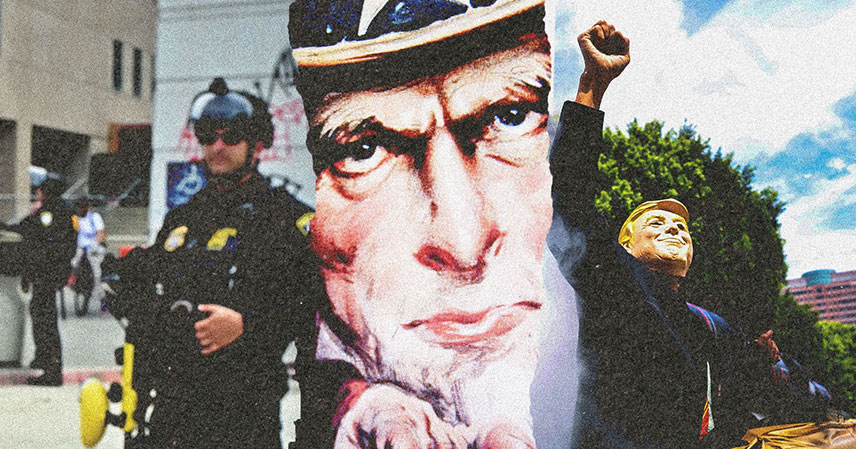In a move that’s as shocking as it is unsettling, the Department of Homeland Security (DHS) has embraced a new propaganda strategy: using viral memes and popular culture to normalize mass deportations. This isn’t just about sharing funny cat videos; it’s a calculated attempt to reshape public perception of immigration enforcement, and its implications are far-reaching.
By leveraging the infectious nature of online trends, the DHS is subtly shifting the narrative, making harsh immigration policies seem acceptable, even humorous, to a significant portion of the population. This strategy raises serious questions about the ethical boundaries of government communication and the potential for manipulation in the digital age.
The “Jet2 Holiday” Meme and its Dark Twist ✈️
The summer of 2025 saw the “Nothing Beats a Jet2 Holiday” jingle from a British budget airline go viral. The DHS, however, saw an opportunity. They created a video using the catchy tune, but instead of showing idyllic vacations, it depicted ICE detainees boarding a deportation plane. The caption? “When ICE books you a one-way Jet2 holiday to deportation. Nothing beats it!”
While many supporters found this “hilarious,” the video’s true intent is far from funny. It trivializes the serious human rights implications of deportation, turning a traumatic experience into a lighthearted meme. This tactic effectively desensitizes viewers to the reality of mass deportations.
A Pattern of Meme-Based Propaganda 🎭
The “Jet2” video wasn’t an isolated incident. Government social media accounts, particularly those belonging to DHS, ICE, CBP, and the White House, have increasingly adopted a meme-heavy approach. Posts featuring alligators wearing ICE hats (“Alligator Alcatraz”), videos using TikTok soundtracks to depict border patrol, and even recruitment posters repurposing vintage car ads are all part of this strategy.
These memes aren’t random; they’re carefully selected to resonate with specific demographics. The use of popular songs and images from the online world aims to connect with younger audiences, particularly those active on platforms like TikTok and Instagram. This calculated approach demonstrates a sophisticated understanding of digital media and its power to influence public opinion.
Targeting Specific Demographics and Narratives 🎯
The administration’s meme strategy isn’t just about humor; it’s about reinforcing an “us vs. them” mentality. By portraying migrants as criminals and emphasizing border security, these posts tap into existing anxieties and prejudices. The use of callous jokes, often recycled from far-right online communities, further solidifies this divisive narrative, creating a landscape where government messaging is amplified while independent voices like comedians face scrutiny for their own free speech.
The strategy also incorporates elements of Christian nationalism, appealing to specific religious and political beliefs. This multifaceted approach allows the administration to reach a broad audience, manipulating emotions and prejudices to garner support for its policies.
The Far-Right Connection and Viral Amplification 📣
The DHS’s adoption of memes originating from far-right online spaces is particularly troubling. The blatant appropriation of content from accounts like “Libs of TikTok” shows how easily extremist rhetoric can be mainstreamed through government channels. This integration normalizes the casual cruelty often found in these online communities.
The viral nature of these memes further amplifies their message. A post initially shared on a small account can quickly gain traction, reaching millions of people through reposts and shares. This demonstrates the power of social media in shaping public discourse and the potential for manipulation by those who understand its mechanics.
ICE Recruitment and the “Fun Fraternity” Illusion 👮♂️
The administration’s plan to hire 14,050 ICE officers over the next three years, coupled with the removal of age limits from applicants, is further evidence of a concerted effort to expand deportation operations. The meme strategy serves as a recruitment tool, attempting to portray ICE as a fun and exciting organization.
This carefully crafted image aims to attract applicants who might otherwise be hesitant to join an agency associated with controversial and often inhumane practices. By creating a façade of camaraderie and adventure, the administration seeks to mask the harsh realities of the job.
Key Takeaways 🔑
- The DHS is using viral memes and popular culture to normalize mass deportations.
- This strategy targets specific demographics and reinforces an “us vs. them” mentality.
- The government’s adoption of memes from far-right sources normalizes extremist rhetoric.
- The meme strategy is used as a recruitment tool for ICE, portraying the agency in a positive light.
- This raises serious ethical concerns about government communication and manipulation in the digital age.
The DHS’s meme strategy is a concerning example of how propaganda can be subtly and effectively used to shape public opinion. The normalization of harsh immigration policies through seemingly harmless memes highlights the importance of media literacy and critical thinking in the digital age. We must remain vigilant against attempts to manipulate our perceptions and challenge the narratives presented to us online.
Source: The Trump Administration Is Using Memes to Turn Mass Deportation Into One Big Joke



